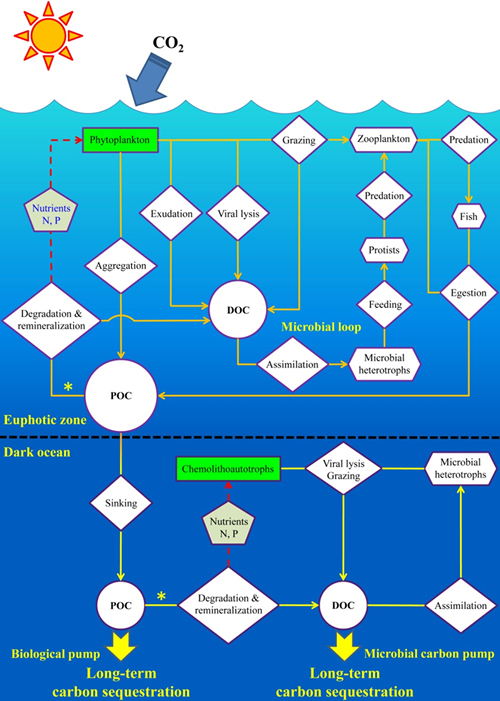海洋颗粒物及其它固体表面附着微生物往往与海水中自由生活的微生物有着不同的种类组成和功能过程,它们在海洋营养盐再生、碳氮磷硫铁等生源要素循环、环境污染物降解、食物网物质、能量和遗传信息流动中发挥着重要作用。附着微生物不但通过呼吸作用影响海洋颗粒有机物(POM)的降解,从而影响海洋POM的再矿化深度、海洋生物泵储碳作用、海洋对大气CO2浓度及全球气候变化的调节作用,而且,附着微生物在降解POM的同时,加速营养盐再生,从而促进海洋真光层的光合固碳作用及弱光和无光层的微生物化能自养固碳作用(图1),对全球气候变化和海洋环境变化发挥重要作用。

图1 . 海洋碳循环及附着微生物参与的关键过程和作用
Fig 1. The marine carbon cycle and the key ecological processes and biogeochemical functions provided by surface-associated microorganisms
(Dang & Lovell, 2016. Microbiology and Molecular Biology Reviews)
党宏月教授早年在美国学习期间,在国际上率先建立了海水附着微生物群落早期演替等分子生态学研究方法,通过定性和定量研究,在国际上首次发现海洋玫瑰杆菌(Roseobacter clade)等为大西洋海水附着微生物群落的先锋定殖种,之后在中国自然科学基金项目资助下,在太平洋沿岸的研究进一步证实了这类海洋细菌对附着微生物群落的重要贡献,系统揭示了这一全球性的海洋微生物生态现象和规律。同时,团队在国际上首次发现了海洋Zeta变形菌纲化能自养铁氧化细菌是一类早期触发腐蚀、引起碳钢在海水中加速低水位腐蚀的微生物。这些发现不但为揭示海洋附着微生物的生态环境作用等科学研究奠定了基础,而且为开展海水微生物金属腐蚀作用及其防护控制技术研究提供了新思路。
在这些研究发现和成果基础上,党宏月教授与美国南卡罗莱纳大学Charles R. Lovell教授合作,对海洋微生物的固体表面附着及生物膜形成、发育等生态过程和生物地球化学功能进行了系统的理论分析和文献综述,所撰写的论文“Microbial Surface Colonization and Biofilm Development in Marine Environments(海洋环境微生物固体表面定殖与生物膜发育研究)”最近在国际微生物学著名专业学术期刊Microbiology and Molecular Biology Reviews (Top Journal, SCI影响因子14.611)在线发表。
该综述文章在系统整合和分析该领域近年来所取得的研究进展和成果基础上,深入解析了浸海固体表面和海洋颗粒物附着微生物的遗传、生化、生理、生态、生物地球化学及组学等特征和规律,对比论述了附着微生物对海洋生态系统功能的影响及对海洋工程等的危害作用(如微生物金属腐蚀作用等),分析了海洋附着微生物对全球变化(如海水升温、海洋酸化、海水缺氧等)的响应和影响,并系统地对该领域的未来发展方向、科学研究重点及创新研究突破口进行了前瞻性分析,为海洋微生物附着、生物膜发育及相关的全球变化等研究提供系统的理论基础和科学指导。
这一研究成果是经过多年不懈努力取得的,党宏月教授所发表的研究论文,在国际同行间有较好的学术影响,文章引用率较高,并被Elsevier收录入2014年中国“免疫和微生物学”领域高被引学者榜单。
Prof. Hongyue Dang and Prof. Charles R. Lovell have just published a review paper on Microbiology and Molecular Biology Reviews.
Biotic and abiotic surfaces in marine waters are rapidly colonized by microorganisms. Surface colonization and subsequent biofilm formation and development provide numerous advantages to these organisms and support critical ecological and biogeochemical functions in the changing marine environment. Microbial surface association also contributes to deleterious effects such as biofouling, biocorrosion, and the persistence and transmission of harmful or pathogenic microorganisms and their genetic determinants. The processes and mechanisms of colonization as well as key players among the surface-associated microbiota have been studied for several decades. Accumulating evidence indicates that specific cell-surface, cell-cell, and interpopulation interactions shape the composition, structure, spatiotemporal dynamics, and functions of surface-associated microbial communities. Several key microbial processes and mechanisms, including (1) surface, population, and community sensing and signaling, (2) intraspecies and interspecies communication and interaction, and (3) the regulatory balance between cooperation and competition, have been identified as critical for the microbial surface association lifestyle.
In this review, recent progress in the study of marine microbial surface colonization and biofilm development is synthesized and discussed. Major gaps in our knowledge remain. We pose questions for targeted investigation of surface-specific community- level microbial features, answers to which would advance our understanding of surface-associated microbial community ecology and the biogeochemical functions of these communities at levels from molecular mechanistic details through systems biological integration.
The key points presented in this review include:
1) Marine particle- and surface-associated microorganisms usually possess unique species composition, ecological processes and biogeochemical functions, which are generally different from their free-living counterparts. Particle- and surface-associated microbiota play important roles in nutrient regeneration, bioactive element (such as C, N, P, S and Fe) cycling, environmental pollutant biodegradation, and the flows of matter, energy and genetic information in marine food webs.
2) The formation and development of surface-associated marine microbial communities generally follow successional patterns, in which marine Roseobacter clade bacteria are usually the early-stage pioneer colonizers, particularly in coastal waters. Complex interactions such as cooperation and competition are prevalent among surface-associated microorganisms, laying the foundation for the establishment of compositional diversity and functional processes of the marine surface-associated microbiota.
3) Surface-associated microbiota influence, via microbial respiration, the biodegradation of marine particulate organic matter (POM), and thus the remineralization depth of sinking POM, the carbon sequestration efficiency of the biological pump, and the ocean's modulation capacity of atmospheric CO2 concentration and climate change. Furthermore, surface-associated microbiota prompt the regeneration of nutrients through POM biodegradation, thus enhance photosynthetic CO2 fixation in the euphotic zone and chemolithoautotrophic CO2 fixation in the twilight and aphotic zones (Fig. 1). Therefore, surface-associated microorganisms play important roles in the modulation of global climate change and the ocean's environmental change.
Citation: Dang HY & Lovell CR. 2016. Microbial Surface Colonization and Biofilm Development in Marine Environments. Microbiology and Molecular Biology Reviews. 80 (1): 91-138. Doi: 10.1128/MMBR.00037-15.
Link to full text: http://mmbr.asm.org/content/80/1/91.full.
|